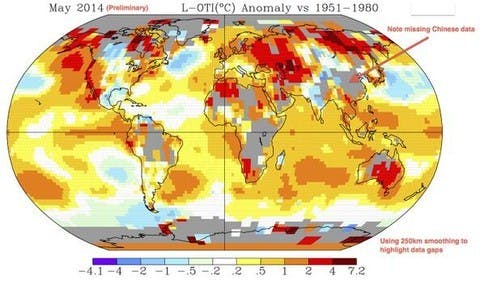According to new data released this week, May 2014 is officially the warmest May in recorded history.
Both NASA and the Japan Meteorological Agency have tentatively ranked May at the top of historical measurements, though NASA’s numbers are preliminary because crucial information is still missing from China.
Gavin Schmidt, the director of NASA’s Goddard Institute for Space Studies, which maintains NASA’s global temperature database, explained the Chinese data glitch:

Infographic: Gavin Schmidt/ @ClimateOfGavin
Still, the fact that NASA and the Japan used different calculation methods to arrive at similar results is telling. Another agency, National Oceanographic and Atmospheric Administration, will release its estimate of May global temperatures next week using a third method.
“
Preliminary numbers show the combined global land and ocean temperature during May deviated from that baseline by about three-quarters of a degree Celsius, the most of any May since accurate records began in 1880
The exceptionally warm month was egged on by a building El Nino in the tropical Pacific. Europe, Central Asia, Russia, Japan, Australia, Southern Africa, Brazil, Eastern Canada and Western North America (so, basically everywhere) were warmer than normal last month.
Besides shifting weather patterns worldwide, that extra El Nino-fueled ocean warmth is supercharging the Earth’s temperature, which could help make 2014 the warmest year since human records have been kept, and probably for much longer.
El Nino’s effects should peak between October and December and will likely continue into early 2015.
NASA uses a baseline set from 1951-1980 to determine how much a month’s temperature deviates from normal. The agency’s preliminary numbers show the combined global land and ocean temperature during May deviated from that baseline by about three-quarters of a degree Celsius, the most of any May since accurate records began in 1880. The 0.76 degree Celsius anomaly is tied for the sixth-largest anomaly for any month since 1880.
All 10 of the biggest monthly temperature anomalies on record have occurred since 1995, according to NASA:
- January 2007: 0.93
- March 2002: 0.89
- March 2010: 0.87
- February 1998: 0.86
- April 2010: 0.82
- October 2005: 0.76
- May 2014: 0.76*
- February 1995: 0.75
- June 1998: 0.75
- November 2013: 0.75
- *Preliminary
In April, monthly concentrations of carbon dioxide reached 400 parts per million for the first time in at least 800,000 years. On our current path of minimal attention, scientists say warming could exceed 4.5 degrees Celsius by 2100 - which would have devastating effects.
Eric Holthaus is a meteorologist who writes about weather and climate for Slate’s Future Tense.










